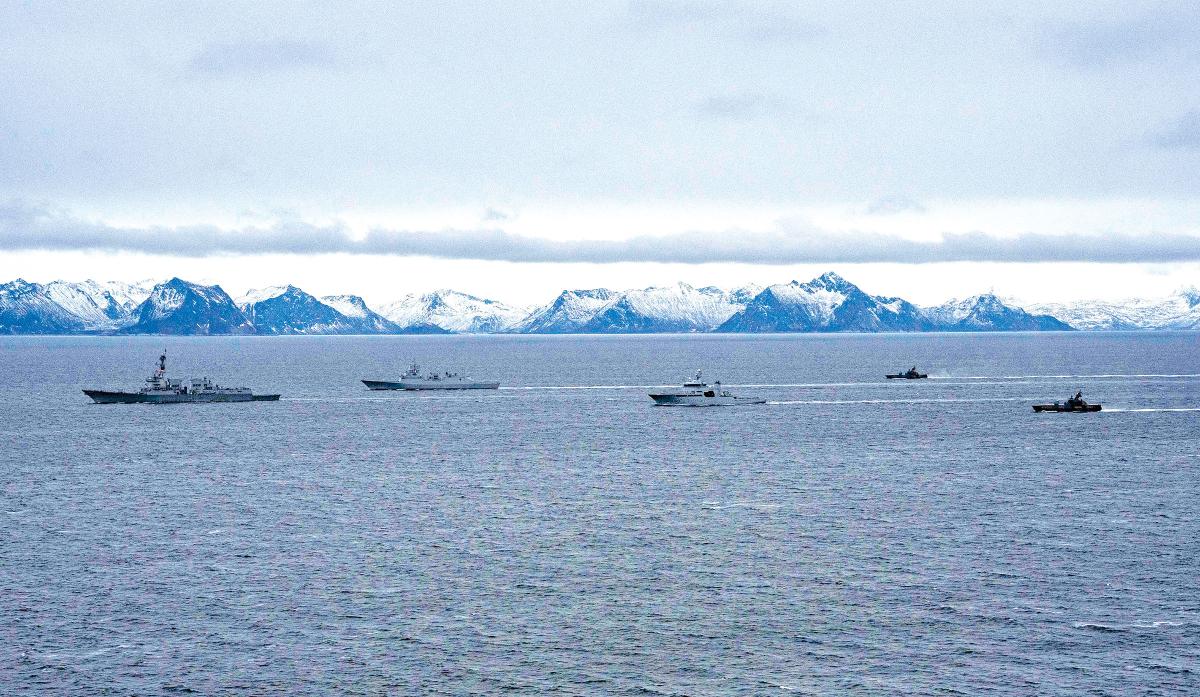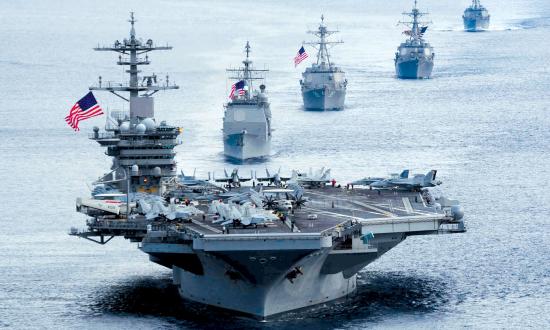The end of the Cold War and a shift in focus to regional threats and terrorism created a blind spot in the Atlantic that was largely ignored for many years. Naval and joint forces deployed from East Coast bases to operate in regions other than the Atlantic and Arctic. Recently, however, U.S. and NATO leaders acknowledged the Atlantic is a contested space that can no longer be ignored, especially given multiple deployments of Russia’s quietest submarines within weapons range of major East Coast cities. Navy leaders announced renaming Fleet Forces Command as U.S. Atlantic Fleet, emphasizing the need to refocus on the Atlantic.
Today, when our sailors take in lines and set sail, they should expect to operate in a contested space as soon as they leave Norfolk, New London, Mayport, Kings Bay, or Halifax. An increasing number of Russian submarines are deploying to the Atlantic—with greater capabilities, more lethal weapon systems, and for longer periods. Russia also has returned to Soviet-era outposts in the North and in the Mediterranean and has built new military facilities above the Arctic Circle. Its new icebreaking ships are capable of launching Kalibr missiles.
In response to Russia’s military resurgence, the U.S. Navy reestablished Second Fleet (C2F) in 2018, and NATO’s North Atlantic Council announced the formal activation of Joint Force Command Norfolk (JFCNF) in 2019. Both commands are headquartered in Norfolk, Virginia, and are led by a single U.S. commander. In October 2020, the NATO- accredited Combined Joint Operations from the Sea (CJOS) Center of Excellence was added. The focus of all three organizations is to ensure the strategic lines of communication across the Atlantic and through the Arctic remain secure and free.
Great power competition will be driven by investments in gray matter as much as gray hulls. Adversary technology and weapons development are catching up to those of NATO. We must create an advantage through how we train and fight. As a fleet commander, I am tasked with the employment of naval forces, and as a joint force commander, with the employment of joint and multinational forces. As these commands continue to develop, we must focus on operational learning to assess our own strengths and weaknesses and to understand the competition and the battlespace in which we will operate. For example, in July, Navy Warfare Development Command facilitated the Fourth Battle of the Atlantic tabletop discussion, which presented U.S. and allied commanders from both sides of the Atlantic with vignettes to address command relationships, resources, mission priorities, and authorities. Insights derived from the exercise are creating a shared understanding of the maritime security environment in the Atlantic and Arctic among all participants and will help to define JFCNF’s role as the command matures.
Both JFCNF and C2F are shifting their mind-sets from predominantly operating from the sea to fighting at sea—which requires mastery of the domains below, on, and above the sea. We are executing high-end maritime operations from seabed to space. Our collective security and interconnected global economy depend on open shipping lanes, unhindered air travel, and uninterrupted flow of data. While C2F is a maritime operational command focused on Atlantic operations, JFCNF’s mission is joint and combined—requiring close coordination across all domains, with cooperation among various national and allied commands in the region. With a shared commander, mission, and geography, C2F and JFCNF are natural partners—each advocating for the other and working in unison.
While no “battle” is currently under way, Russia has increased its military posture during the past decade, to signal its ability to threaten allied capabilities, infrastructure, and territory. Russia has invested in capability versus capacity—it knows it will never have more ships, aircraft, or submarines than all of NATO—with an eye toward asymmetric capabilities. So, we carefully monitor Russian investments in force multipliers such as hypersonic weapons, submarine quieting, extended-range missile systems, and information warfare.
Russia’s activity in the gray zone notably includes its underwater reconnaissance program and information operations. In recent years, Russia intensified its submarine activity around the undersea cables, which are essential for global communications—including the internet. The ability of an American user to access a website in Europe or vice versa largely depends on a network of several hundred fiber-optic communication cables that run across the ocean floor—and Russia has deployed submarines to map out the cables, likely in preparation for nefarious activity.
Two Operational Commands at the Ready
At their inception, both C2F and JFCNF embarked on an effort to study policy, strategy, operations, and tactics in the Atlantic and High North. Both teams invested time in discussions with joint partners, foreign allies, academics, and former operational commanders to glean lessons and best practices. We read, studied, and discussed the 100-year history of the first three battles of the Atlantic (World Wars I and II and the Cold War). JFCNF hosted a tabletop exercise to analyze the dynamics of our current engagement in the emerging “Fourth Battle of the Atlantic.” C2F engaged in focused discussions and offsite sessions to define the problems that sparked its reestablishment. Concurrently, JFCNF hosted NATO leaders from sister commands to discuss how to optimize future command-and-control (C2) structures in the Atlantic and Arctic. A combined vision crystallized with the two commands exhibiting lean, agile, expeditionary, persistent, and fully integrated characteristics.
Both commands are designed to be lean. Fully manned, C2F will have about 150 fewer personnel than other U.S. numbered fleets, and JFCNF will have fewer than 150 total officers and enlisted. By comparison, the other two joint force commands in NATO have in excess of 900 personnel. We accomplish our missions by relying on higher headquarters, also located in Norfolk: U.S. Fleet Forces Command for C2F and NATO’s Allied Command Transformation for JFCNF.
Our agility is threefold. First, the commands are physically agile, able to command the flow of forces and capability across the Atlantic. Second, we are designed to be agile across the spectrum of conflict, from peacetime to world war. Finally, we are designed to be agile in our thinking. JFCNF is the only operational NATO command in North America, and its establishment and location in Virginia embody the enduring transatlantic commitment to collective security and defense. JFCNF will aid Supreme Allied Commander Europe in achieving his 360-degree approach to the collective defense and readiness of allies by providing NATO with situational understanding and awareness from the western side of the Atlantic.
The commands are designed to be expeditionary, with a small footprint forward and the capability to reach back to Norfolk. C2F demonstrated this capability in 2019 when we embarked the USS Mount Whitney (LCC-20) to lead Exercise Baltic Operations (BaltOps). In 2020, we established an expeditionary maritime operations center in Keflavik, Iceland, to command and control a surface action group operating north of the Arctic Circle. JFCNF will test these same capabilities, working closely with C2F as a maritime component, to demonstrate the Alliance’s capability to coordinate and deliver transatlantic reinforcement in support of operations in the European theater.
The commands intend to be persistent throughout the Atlantic and into the Arctic. Virtual presence is absence, so we aim to have persistent force presence throughout our areas of responsibility—forward from the United States or forward from Europe, across the Atlantic and the High North. Joint and naval forces that operate under and on the surface, in the air, and across space and cyberspace are maneuver forces. C2F and JFCNF aim to erase lines on maps that have no reference to physical maritime geography (such as straits or choke points) and eliminate the associated vulnerabilities around predetermined seams.
Both staffs also are designed to be fully integrated. Naval, joint, allied, combined, and active/reserve forces are the foundation of the new C2F and JFCNF. As nascent commands, we rely heavily on perspectives from a diversity of thought, background, and experience. At C2F, we have integrated officers from multiple allied nations directly into the fleet staff. The Marines and foreign exchange officers are fully functioning staff members—not just liaison officers—and they include a two-star Royal Canadian Navy officer as the vice commander of C2F. The Navy Reserve also has been foundational to the establishment of both commands. At JFCNF, an initial team of fewer than ten individuals stood up the command, with the help of reserve, joint, and international officers—a testament to integration from its inception. We are also integrating the staff by functional codes (C2F N-codes in the same building with their JFCNF J-codes), and we aspire to use NATO standards for everything from classification to mission orders and associated command-and-control systems to realize our full potential.
Atlantic Operations and the Way Forward
Building two operational commands from the ground up was step one. Our focus now is to integrate and synchronize them. C2F reached full operational capability at the end of 2019, and JFCNF is expected to reach that milestone later in 2021. The addition of NATO’s Combined Joint Operations from the Sea (CJOS) brings a wealth of knowledge and expertise into contact with operational planners and decision-makers. Working together, C2F, JFCNF, and CJOS will ensure U.S. and NATO leaders have options for every crisis or situation that develops throughout the Atlantic or Arctic regions: the right forces, integrated, and ready to be employed in support of operational objectives.
Second Fleet will accomplish this through fleet battle problems—challenging our assumptions and testing new concepts and hypotheses to further our understanding of the environment and changing tactics. We are participating in exercises with allies and partners, such as Operation Nanook, where the USS Thomas Hudner (DDG-116) worked with Canadian, Danish, French, and U.S. Coast Guard ships north of the Arctic Circle. And we will work with other newly formed commands such as Submarine Group Two to practice antisubmarine warfare tactics.
JFCNF will assure and strengthen the Alliance by helping to defend North America, as well as Europe, and deliver continued situational awareness in support of Supreme Allied Commander Europe’s 360-degree approach to collective defense. We are relinking the East Coast of the United States with NATO’s common operating picture through a watch floor embedded within JFCNF. We will lead and contribute to NATO contingency planning, actively participating in allied exercises to develop a high degree of readiness to respond to emerging crises. JFCNF will integrate a diverse command network involving national and NATO commands and entities in coordinating and synchronizing effects.
Today, the JFCNF team is actively working and planning our participation in NATO’s Steadfast Defender 2021, a large-scale, multinational, and operational- and tactical-level exercise that will serve as a milestone for reaching full operational capability. JFCNF will also work closely with C2F, acting as the maritime component, to demonstrate JFCNF’s capability to coordinate and deliver transatlantic reinforcement.
The relationship between C2F, JFCNF, and CJOS will mature as we work together to ensure there is no seam in the Atlantic or the High North for our adversaries to exploit. It demonstrates the enduring commitment on both sides of the Atlantic to protect our shared values and improve our military posture and readiness. The work we do to secure the transatlantic bridge will be fundamental to the United States and the Alliance.






